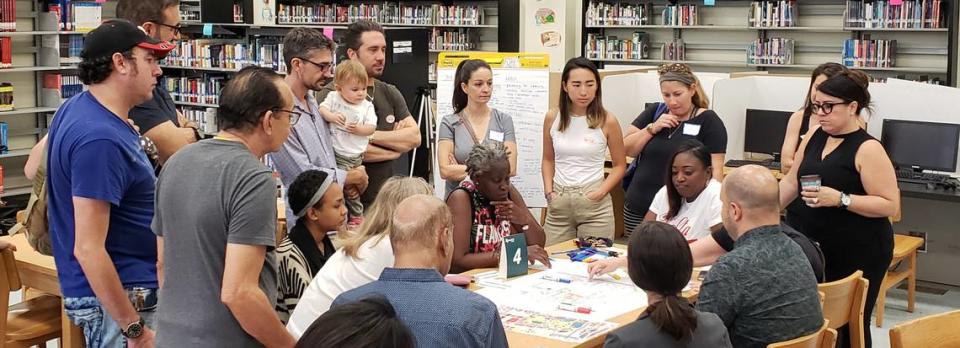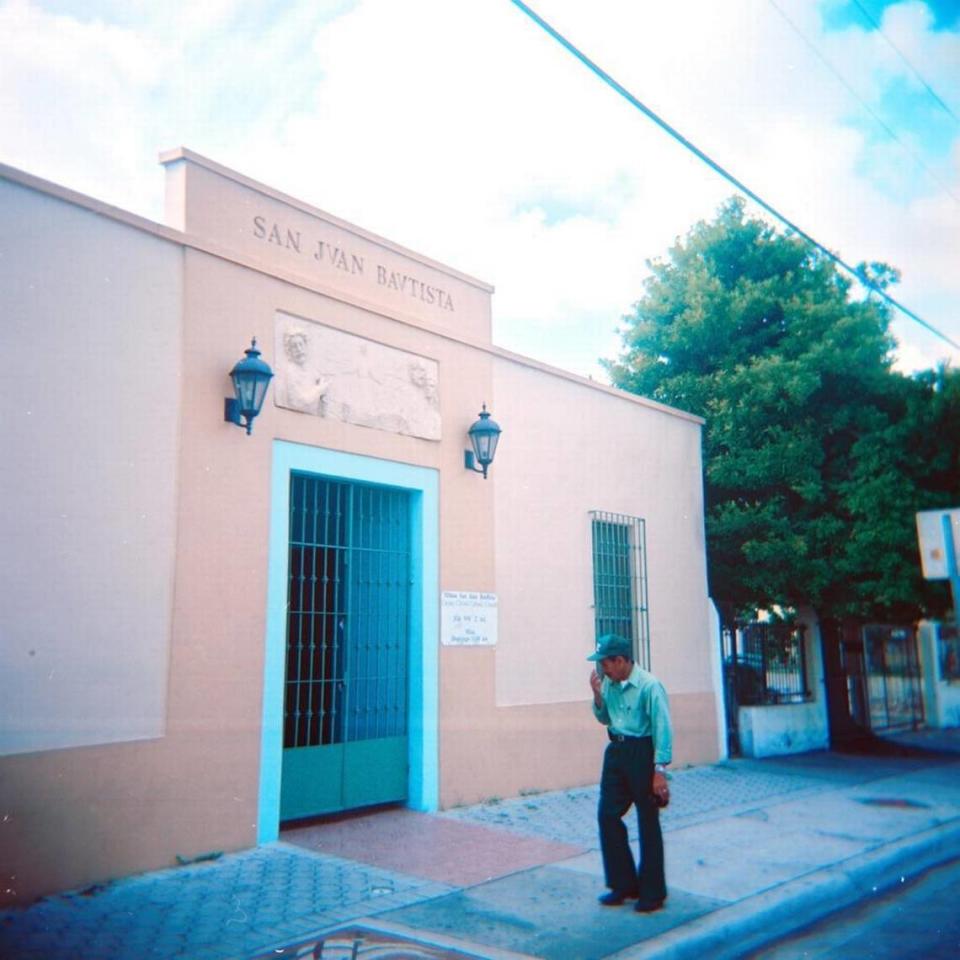To fight gentrification, a working-class Miami enclave wins plan to spur development
Residents and property owners who banded together in the newly rechristened working-class neighborhood of Wynwood Norte have won Miami commissioners’ enthusiastic approval for an innovative plan that would tame looming gentrification by spurring development.
The Wynwood Norte Neighborhood Revitalization District, a special zoning plan approved on first reading by a 5-0 vote on Thursday, arose from a grassroots effort to reverse the historic residential enclave’s declining fortunes. The compact, low-income neighborhood of around 4,000 people has bled population and been mostly overlooked as its better-known southern neighbor, the Wynwood arts and entertainment warehouse district, undergoes a red-hot redevelopment boom
The so-called NRD-2, drawn up by city planners based on a “vision plan” developed by a Wynwood Norte neighborhood association, takes an unusual and seemingly counter-intuitive approach that sponsors hope will be a model for other distressed urban areas where residents are at risk of displacement from redevelopment, gentrification and a shrinking supply of affordable housing.
The plan seeks to attract badly needed investment to the neighborhood, plagued by demolitions and vacant or abandoned lots and buildings, by promoting modestly larger and denser but still small-scale infill development through an extensive upzoning. In exchange for the greater capacity to build across most of the enclave’s 140 acres, developers would provide a significant supply of new affordable housing and help pay for enhancements like new street lighting, shade trees and sidewalks. The upzoning would also allow Miami-Dade County’s housing agency, which owns several acres of underused land in the neighborhood, to expand its local stock of affordable and workforce housing.
To encourage business formation, the new zoning would also allow establishment of micro-retail and incubator spaces.
At the same time, the plan aims to preserve the core and character of the neighborhood by placing stricter limits on demolitions and maintaining a low scale in residential areas. Property owners seeking to demolish a house or building would need to have a permit in hand for new construction, a measure intended to stop the common practice by real-estate speculators of vacating and tearing down usable homes and buildings to flip the empty land for a higher price.

The neighborhood wish list was put on the path to realization last year, when the city commission adopted it unanimously. At the urging of Commission Chairman Keon Hardemon, the commission also instructed the city planning department to translate the vision into zoning legislation.
On Thursday, the often-fractious commission embraced the rezoning plan with no debate and some fulsome praise for Hardemon, who must resign his seat because he’s in a runoff election next month for a Miami-Dade County Commission seat against Haitian-American activist Gepsie Metellus. The enthused unanimity virtually guarantees passage on a second and final vote for the Wynwood Norte plan that would come after a review by the state that’s usually cursory.
“This is a visionary, bold and gutsy plan,” Commissioner Alex Diaz de la Portilla told Hardemon. “This will leave a legacy for this community that will last a long, long time.”
Backers of the plan, which include longtime Wynwood residents, acknowledge it could substantially transform their neighborhood over time. But they say creeping speculation and gentrification are already changing Wynwood Norte, and the plan represents their best hope of corralling development forces to secure more affordable housing and an improved quality of life for residents.
Unlike most upzonings pushed by developers looking for deep profits in poor neighborhoods, supporters of the Wynwood Norte plan contend their pro-active approach will protect renters and its 154 homeowners alike.
“To be clear, nobody’s getting kicked out by this plan — to the contrary,” said Wil Vasquez, who grew up in Wynwood Norte and owns several rental properties in the neighborhood, in recorded comments last week to the city planning and zoning board, which also endorsed the NRD-2 plan.
Because longstanding zoning rules don’t allow sufficient density to make it viable to build on the neighborhood’s small lots, there has been virtually no private investment in Wynwood Norte in decades, Vasquez and others say. But as development booms to the south and in Midtown Miami to the east, they say developers are already moving in, and they fear the lot aggregation and large-block redevelopment that’s the only way to build under current Miami 21 zoning would displace those who remain.
Residents were spurred into action by development plans from a Texas-based developer, Westdale Real Estate Investment Management. The firm bought a block of mostly rundown residential properties in the neighborhood and obtained city zoning approvals for a plan to raze them and build a low-scale housing and retail complex aimed at a range of incomes, including so-called workforce housing that goes for higher rents than legally defined affordable housing.
With development plans on hold, Westdale agreed to back residents, small property owners and other neighborhood stakeholders seeking a better deal.
Westdale paid for the Wynwood Norte vision plan by Plusurbia Design, a prominent Miami planning firm. A local Westdale partner joined the new neighborhood association board, and Steve Wernick, an attorney who represents the developer, helped shepherd the plan, shaped in numerous neighborhood meetings over two years, to approval. Wernick said Westdale’s involvement in the plan has been “minimal” and much of his work on behalf of the association has been as a volunteer.
The protections built into the zoning plan will strongly discourage aggregation while fostering small-lot infill construction of apartment buildings, townhomes and duplexes as well as shops, city planners say. The new rules would grant developers modestly increased capacity to build on those small lots while requiring they set aside 10 percent of apartments at affordable rents — defined as rates affordable to households making less than 80 percent of the Miami-Dade County median annual income, now around $60,000.
City planners say the new zoning could produce up to 9,000 new apartments, most in buildings of three to five stories, though some structures could go as high as 12 stories on the neighborhood’s edges. As many as 1,400 of those units could be new “income-restricted” affordable apartments, Wernick said.
“The Wynwood Norte Neighborhood Revitalization District provides real solutions for Miami’s affordable housing crisis that are uniquely tailored to the neighborhood,” Wernick, whose firm is in Wynwood, said in a statement released after the commission vote.

The existing zoning has done nothing to stem a population drop or prevent the extensive demolition of homes and commercial buildings, noted Vasquez, whose 92-year-old father still lives in Wynwood Norte.
“We are tired of being ignored and stuck with bad zoning that’s keeping the neighborhood down,” said Vasquez, who sits on the board of the Wynwood Norte Community Enhancement Association, the group behind the new plan.
The zoning plan was supported by the priest at the local Catholic church, San Juan Bautista Mission, the head of the De Hostos Senior Center and the director of the Bakehouse Art Complex, a building that houses low-cost art studios and exhibition spaces. Bakehouse interim director Cathy Leff, also a member of the association board, said the rezoning will allow the nonprofit to move forward with plans to build affordable housing for artists and their families on the Bakehouse parking lot.
Wynwood Norte consists of a 35-block area that runs between Northwest 29th and 36th Streets from Interstate 95 to Miami Avenue, in the heart of Miami’s historic urban core.
Formerly known as Little San Juan, the neighborhood at its peak after World War II was home to Puerto Rican garment workers employed in the clothing and shoe industry in the warehouse district to the south.
But as the industry and the warehouse district went into a steep decline in the 1980s, the once-stable residential enclave became increasingly impoverished and plagued by drug trafficking and high crime. Most of its Puerto Rican population is long gone, but a core of longtime residents has endured through several generations.
The Wynwood Norte approach was modeled on the city’s first neighborhood revitalization district in the Wynwood arts district.
The arts district plan, backed by business and property owners, created new zoning to spur development of residential and mixed-use projects on a compatible scale and look in the old warehouse district, which had little housing, in order to make it a true urban neighborhood. That plan has led to construction of half a dozen new projects and has allowed the city to block developers seeking further upzonings, city planners say.


